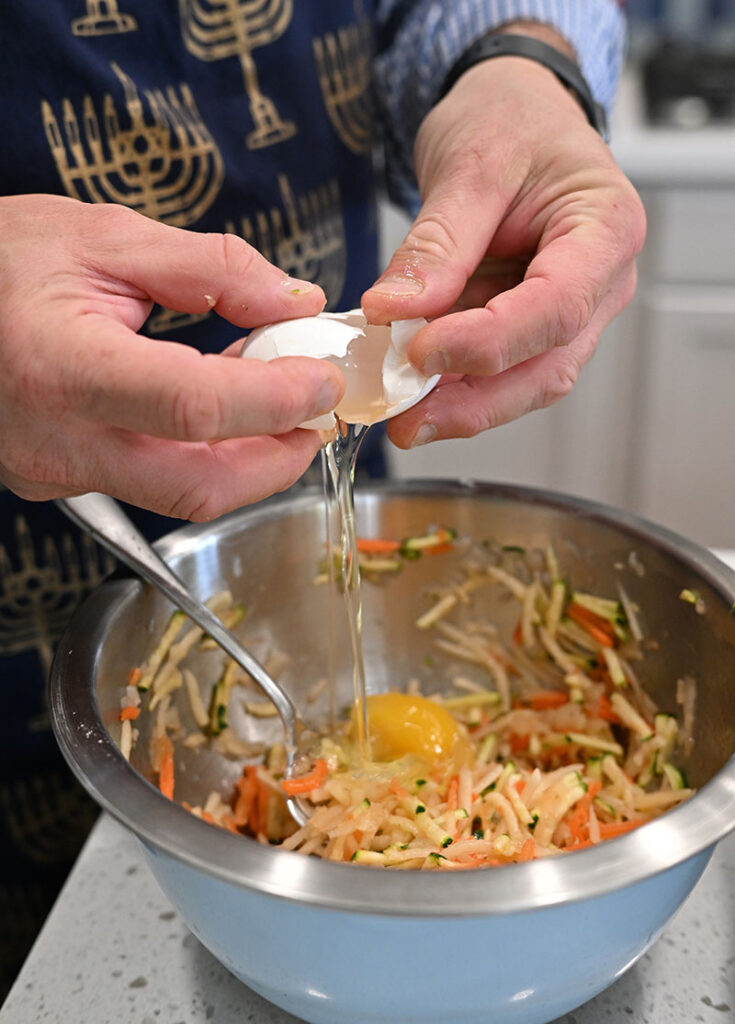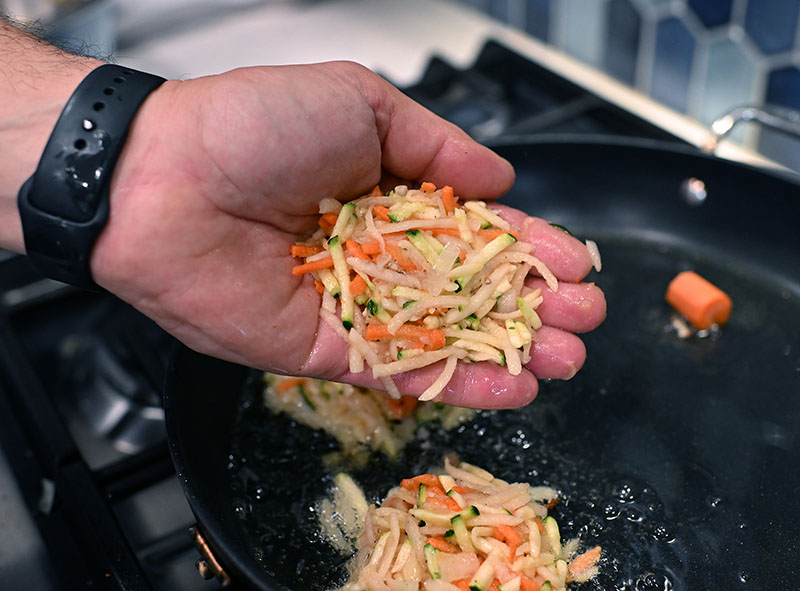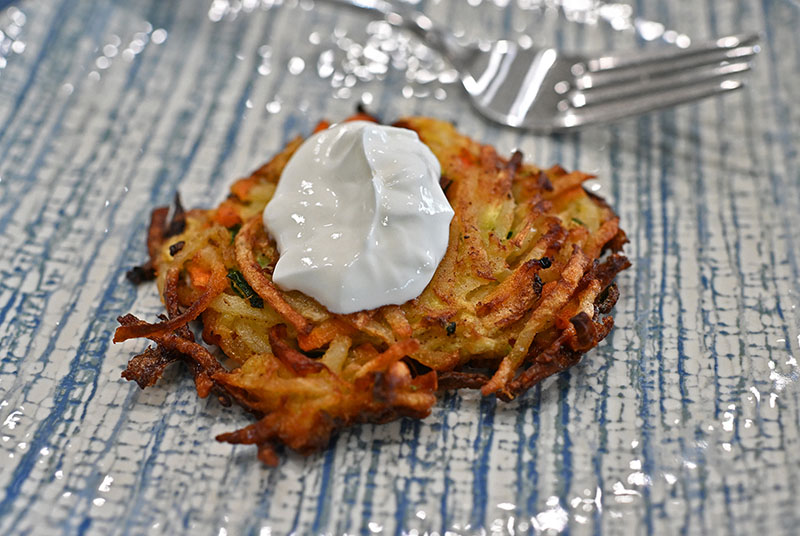Crispy latkes celebrate Jewish high holiday.
Latkes are one of those traditional foods that don’t usually end up on a restaurant menu. Rather, they are fried up in the cozy kitchen of a bubbe, or Jewish grandmother.
“The grandmothers tell us the stories of shredding the potatoes and cutting their knuckles with the grater. The love of latkes is so intense that they get their knuckle skin into the recipe,” says Mara Langer, director of community engagement (Northern Nevada) for Jewish Nevada.
(To avoid grated knuckles, a food processor also can be used.)
Many cultures have their versions of the potato pancake, but the Jewish latke, traditionally served during Hanukkah, has an entire back story and particular recipe.
Fried Festivities
The word latke is the Yiddish word for pancake. Hanukkah is celebrated for eight days and nights starting at sundown on the 25th day of Kislev, according to the Hebrew calendar, which can be any time from late November to late December in the Gregorian calendar.
The holiday commemorates the Maccabean Revolt against Syrian Greek King Antiochus who banned Jewish religious practices around 168 BCE. After the Jews prevailed, the Temple of Jerusalem was rededicated with a lighting of the menorah, or multi-branched candelabra. During the lighting, there was only enough oil to burn for one night, but it miraculously lasted for eight nights.
“The whole holiday is based around food fried in oil, and the latke is one of those fried foods that we eat to commemorate this holiday,” Langer says.
Traditionally made with shredded potatoes and onions, latkes are sometimes featured in Jewish delis as an appetizer, usually accompanied by sour cream and applesauce.
Potato-less Pancakes?
While the idea of frying food in oil is ancient, the use of potatoes in latkes is more recent. Before potatoes were brought to Europe from South America in the 1500s, latkes are thought to have been made from vegetables or cheese. The current recipe was most likely to have been brought to the United States by Polish Jewish immigrants.
Langer says that the Hanukkah version is strictly made with potatoes, but she has seen some variations of the latke made with sweet potatoes, zucchini, carrots, and za’atar, a Middle Eastern spice blend.
“There are so many different traditions and variations on what people put into them,” she says. “Some families might make different cultural versions such as a Thai or Asian version. People get very creative with them.”
It’s a rare restaurant dish for our area, but a classic bubbe version can be enjoyed locally at the Atlantis Casino Resort Spain Reno. The Manhattan Deli inside the resort serves latkes as an appetizer with plenty of sour cream and applesauce.
Homemade Latkes
If you want to make traditional latkes at home, Will Sheppard, chef at Madein Food & Drink Collective in Reno (and formerly head chef of Estella Tacos y Mezcal in Reno), has a few tips. Sheppard grew up in New York City’s West Village and lived in Brooklyn as an adult.
“The grandma style of Jewish cooking is not that common outside of big cities,” Sheppard says. “There is an element of the Jewish cuisine that doesn’t explain what it is right away.”
Some examples that might come to mind are gefilte fish and matzo balls, both served during Passover. They might need some explanation, but a potato pancake is pretty self-explanatory.
“There is a broad appeal to the fried potato. Latkes are not easy to make, but they are simple to make,” Sheppard says. “There are a lot of steps to it, and you are kind of on it the entire time, as opposed to setting something up and letting it do its own thing. They are an active [dish to] cook, but a fairly straightforward [one].”
Sheppard likes to grate his potatoes with the skin on and prefers white onions. He says you will get a better result by using a grater, but a food processor will give you the same result. He adds that an ice cream scoop is a handy tool for spooning the batter into the oil.


For the oil, he prefers to use duck fat or schmaltz, which is a mixture of rendered chicken fat and butter.
“Any oil with a decently high smoke point will work,” he says.
Sheppard says that you will want to make sure the first side of the latke is fairly dark before flipping it, or it could fall apart. Warm latkes can be topped with a sprinkling of salt. Sheppard likes to top his with a dash of ground fermented black garlic found at Trader Joe’s.
While some Jewish grandmothers might balk at straying from the traditional latkes, their straightforward ingredients and traditional toppings are ripe for your own customization.
“It’s a house food versus a restaurant food,” Sheppard says.
Langer Latkes
(courtesy of the Langer family in Reno. Makes about 10 to 12 latkes)

1 pound potatoes, russet or Yukon gold
½ large white onion
1 large egg
½ teaspoon sea salt
¼ teaspoon black pepper
1¼ cups canola or avocado oil
Peel potatoes and place in a large bowl with water to keep them from turning brown. Cut potatoes into quarters and shred with a large grater or food processor.
Take two handfuls of shredded potatoes and place them in a dish towel. Twist the towel to squeeze the starchy juice from the potatoes into the sink. Undo the twist, fluff potatoes, and squeeze once more to dry out the potatoes as much as possible. Place shredded potatoes in a large bowl.
Peel onion and cut into quarters. Shred onion using a fine-shred grater or food processor. Combine shredded onion, onion juice, and shredded potatoes and mix.
Whisk egg, salt, and pepper together in a small bowl. Combine egg mixture with potatoes and onions.
Heat oil in a 12-inch nonstick skillet over medium-high heat until hot but not smoking. The oil should cover the bottom of the skillet and be about ½ inch deep.
Make a latke patty about the size of your palm. Don’t make them too thick, as you want the centers to cook but the outsides not to burn. Squeeze out any excess water before adding patty to the pan. The drier the mixture, the crispier the latkes.
Cook latkes for about 3 minutes on each side until golden brown. Cook them longer for additional crispiness.
The oil can blacken and add a bitter flavor to the latkes. After 2 batches, wipe out the oil and heat more for a new batch.
Transfer cooked latkes to paper towels to drain the oil.
You can keep your latkes warm until you are ready to serve them: Set the oven to warm, place latkes on a cooling rack atop a baking sheet, and place sheet in oven. Rest for about 10 minutes before serving. Serve with applesauce and sour cream.
Keep any leftover latkes in an airtight container in the fridge or as a single layer in plastic bags in the freezer. Reheat them at 325 degrees F.


